
— Emergency responders sent to an electric vehicle fire may not be able to depend on the emergency response guide provided by the automaker.
That finding comes from the National Transportation Safety Board (NTSB) after investigating four electric vehicle fires involving high-voltage lithium-ion batteries.
The government has investigated multiple electric car battery fires that kept medics and fire departments on their toes, sometimes for days after originally putting out the fires. Even towing companies have faced the wrath of lithium-ion car batteries while hauling the cars away from crash scenes thinking the fires were extinguished.
A fire in an electric vehicle powered by a high-voltage lithium-ion battery can kill people from electric shocks caused by components of the damaged battery.
The damaged cells in the battery can also suffer thermal runaway, an uncontrolled increase in temperature and pressure which can cause the batteries to burn for hours or possibly days.
For example, the battery pack for a Tesla Model S uses more than 7,000 lithium-ion cells, each battery cell larger than a standard AA battery. Those 7,000 battery cells hold "stranded" energy that remains in a damaged electric car battery.
In the case of a Tesla Model X crash, investigators determined the battery reignited five days after the fire was originally extinguished.
In the latest NTSB study, three of the lithium-ion batteries that ignited were damaged in very severe high-speed crashes, while the fourth lithium-ion battery fire occurred during normal vehicle operations.
All three crash-damaged batteries reignited after firefighters extinguished the vehicle fires, but the battery in the fourth investigation did not reignite.
Safety investigators found an "inadequacy of vehicle manufacturers’ emergency response guides," and determined problems were caused by "gaps in safety standards and research related to high-voltage lithium-ion batteries involved in high-speed, high-severity crashes."
The government says more research is needed on ways to "deenergize" the stranded energy that remains in a damaged electric car battery. Additionally, more needs to be done concerning how to store an electric vehicle with a damaged lithium-ion battery.




